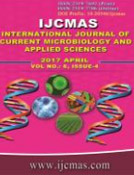


 National Academy of Agricultural Sciences (NAAS)
National Academy of Agricultural Sciences (NAAS)

|
PRINT ISSN : 2319-7692
Online ISSN : 2319-7706 Issues : 12 per year Publisher : Excellent Publishers Email : editorijcmas@gmail.com / submit@ijcmas.com Editor-in-chief: Dr.M.Prakash Index Copernicus ICV 2018: 95.39 NAAS RATING 2020: 5.38 |
Antimicrobial resistance is a growing threat worldwide. Increasing resistance to third generation cephalosporins has become a cause for concern. The prevalence of extended spectrum–lactamases (ESBLs) and metallobetalactamases (MBL) among members of Enterobacteriaceae constitutes a serious threat to current -lactam therapy leading to treatment failure. A total of 276 Gram negative isolates were processed. ESBL was detected by phenotypic confirmatory disc diffusion test (PCDDT) using ceftazidime alone and in combination with clavulanic acid. MBL detection was done by Imipenem EDTA combined disc diffusion test and Modified Hodge test. Out of 276 isolates 69 (25%) were ESBL producers, 70 (25.3%) were MBL producers and 26 (9.42%) were both ESBL and MBL producers. Highest ESBL production was seen in Escherichia coli (46%) and maximum MBL production was seen in Klebsiella pneumoniae (34.8%).The study underlines problem of ESBL and MBL mediated resistance, which has created a therapeutic challenge for the clinicians and microbiologists. Simple disk method can be routinely employed to detect these common resistance mechanisms which will reduce the mortality and also spread of such resistant strains.
 |
 |
 |
 |
 |